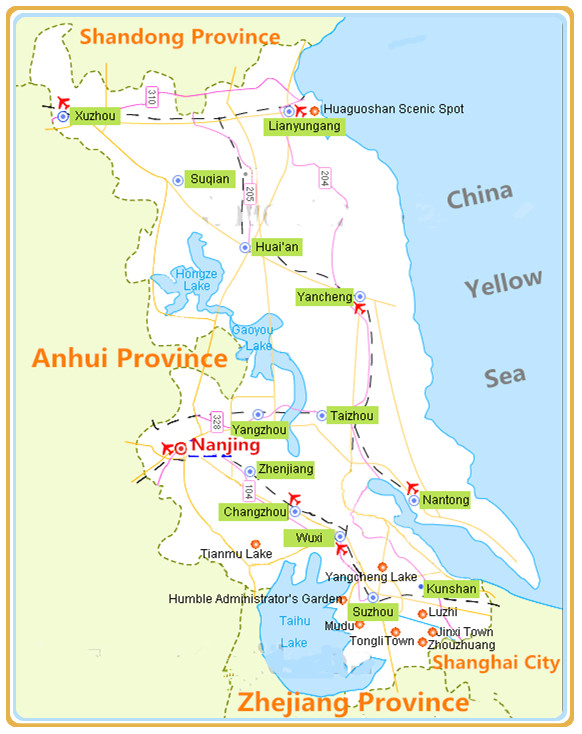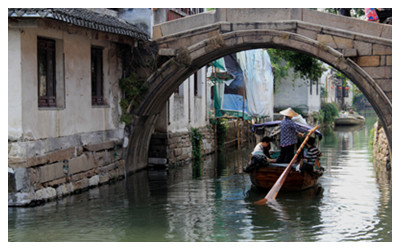Skype: neodalle-travel
Tel: +86 135 7447 2266
E-mail: sales@visitaroundchina.com
 Jiangsu is one of the provinces of China, which has 106 county-level divisions that are further classified into 13 prefecture-level cities as its jurisdictional divisions. The province neighbors Anhui, Shandong, Zhejiang and Shanghai. Located in the downstream area of the Yangtze River along China eastern coastline, it is known as the "country of fish and rice" and the "land of rivers and lakes". The two names allude to the rich, fertile land or the region that is crisscrossed by a network of rivers and canals, and dotted with lakes and reservoirs.
Jiangsu is one of the provinces of China, which has 106 county-level divisions that are further classified into 13 prefecture-level cities as its jurisdictional divisions. The province neighbors Anhui, Shandong, Zhejiang and Shanghai. Located in the downstream area of the Yangtze River along China eastern coastline, it is known as the "country of fish and rice" and the "land of rivers and lakes". The two names allude to the rich, fertile land or the region that is crisscrossed by a network of rivers and canals, and dotted with lakes and reservoirs.Jiangsu Province has a land of 102,600 km2 and a population of almost 80 millions. Its southeastern and northern parts are surrounded by mountains, and a vast plain spreads across the centre of the prefecture. There are numerous large bodies of water covering the area, including Yangtze River, Great Canal, and many other fresh water lakes. Therefore, especially, the southern region entitles with the biggest lake district of China. The province’s climate is moist and mild, and has four distinct seasons. Jiangsu consists largely of the alluvial plain of the Yangtze River and includes much of its delta. Its elevation rarely rises above sea level although there are hills in southwest. The fairly warm climate, moderate rainfall, and fertile soil make Jiangsu one of the richest agricultural regions of China and one of the most densely populated. The Grand Canal, constructed in the 7th century, bisects the province, providing a valuable link between the coast and inland China.
 Marvelous rivers and mountains are not the only attractions that tempt visitors to Jiangsu. The province, in particular the capital city Nanjing, brags a fascinating history. Crumbling city walls, venerated mausoleum and statues of vehement leaders are strong reminders of its brilliant past. Nanjing has enjoyed a 2,400-year history of prosperity since the Warring State Period, and has been the capital of China during eight dynasties. There are also sights of cultural interest scattered liberally throughout Jiangsu from the ancient ornamental gardens of Suzhou to Wuxi's world-record breaking bronze Buddha.
Marvelous rivers and mountains are not the only attractions that tempt visitors to Jiangsu. The province, in particular the capital city Nanjing, brags a fascinating history. Crumbling city walls, venerated mausoleum and statues of vehement leaders are strong reminders of its brilliant past. Nanjing has enjoyed a 2,400-year history of prosperity since the Warring State Period, and has been the capital of China during eight dynasties. There are also sights of cultural interest scattered liberally throughout Jiangsu from the ancient ornamental gardens of Suzhou to Wuxi's world-record breaking bronze Buddha.
Jiangsu Food
The local cuisine is another incentive for tourists to visit Jiangsu. 'Huaiyang' in style, it is similar to Shanghainese cuisine and makes liberal use of soy, ginger, sugar and Shaoxing wine. ‘Dazha crab’ is the specialty of the region, and in Nanjing salt-cured and pressed duck are delicacies.
Jiangsu Economy
Jiangsu is one of the most developed areas in China in economy, technology and culture. Its industries mainly include manufactures, machinery, electronics, spinning and agriculture., and the total output is one of the largest in the nation. The province’s transportation network is most developed and it is connected throughout the whole province and other provinces, including inland waterway, railroad, airline and highway systems. In recent years, the development of hi-tech and telecommunication has brought it up to a new height.
Jiangsu Education
Jiangsu is also a centre of education and science in China. It has the highest density of academic institutions including university, college, and research institutes. The percentage of educated people is always ranked in the front of the country.
Jiangsu Tourism
Jiangsu has been a tourist paradise ever since ancient times. Nanjing, Suzhou, Yangzhou, Zhenjiang, Changshu, Xuzhou and Huai’an are famous historical and cultural cities. Sixteen cities in the province have been entitled Fine Tourist Cities in the country, including Nanjing, the capital of six dynasties, and Suzhou, the Paradise on the Earth. There are 3 major tourist centers in Jiangsu, namely the Yangtze River Area, the Tai Lake Area and the Xuhuai (Xuzhou and Huai’an) Area. There are now 20 well-known scenic spots, 23 forest parks, 6 tourism and holiday resorts and 461 historical sites under state and provincial protection. Nine classical gardens in Suzhou are designated by UNESCO as world cultural heritage. In 2010, income from domestic tourists visiting Jiangsu amounted to 468.5 billion yuan.
Today, Jiangsu's main cities - Nanjing, Suzhou, Wuxi, Changzhou and Nantong - are thriving industrial centers, and although pollution and development contribute to irritations and eyesores, each retains an individual allure. Spring and fall are the best times to visit - not least because of the millions of plant trees that line the streets of each city 'boulevard-style' - though the summer and winter temperatures are not extreme.
Welcome to China, Let's meet in Jiangsu!
 Ask Questions ?
Ask Questions ?